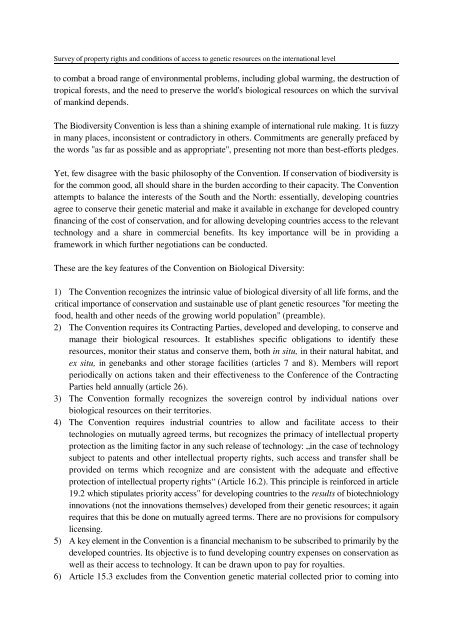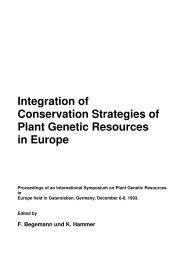Zugang zu Pflanzengenetischen Ressourcen für die ... - Genres
Zugang zu Pflanzengenetischen Ressourcen für die ... - Genres
Zugang zu Pflanzengenetischen Ressourcen für die ... - Genres
Erfolgreiche ePaper selbst erstellen
Machen Sie aus Ihren PDF Publikationen ein blätterbares Flipbook mit unserer einzigartigen Google optimierten e-Paper Software.
Survey of property rights and conditions of access to genetic resources on the international level<br />
to combat a broad range of environmental problems, including global warming, the destruction of<br />
tropical forests, and the need to preserve the world's biological resources on which the survival<br />
of mankind depends.<br />
The Biodiversity Convention is less than a shining example of international rule making. 1t is fuzzy<br />
in many places, inconsistent or contradictory in others. Commitments are generally prefaced by<br />
the words "as far as possible and as appropriate", presenting not more than best-efforts pledges.<br />
Yet, few disagree with the basic philosophy of the Convention. If conservation of biodiversity is<br />
for the common good, all should share in the burden according to their capacity. The Convention<br />
attempts to balance the interests of the South and the North: essentially, developing countries<br />
agree to conserve their genetic material and make it available in exchange for developed country<br />
financing of the cost of conservation, and for allowing developing countries access to the relevant<br />
technology and a share in commercial benefits. Its key importance will be in providing a<br />
framework in which further negotiations can be conducted.<br />
These are the key features of the Convention on Biological Diversity:<br />
1) The Convention recognizes the intrinsic value of biological diversity of all life forms, and the<br />
critical importance of conservation and sustainable use of plant genetic resources "for meeting the<br />
food, health and other needs of the growing world population" (preamble).<br />
2) The Convention requires its Contracting Parties, developed and developing, to conserve and<br />
manage their biological resources. It establishes specific obligations to identify these<br />
resources, monitor their status and conserve them, both in situ, in their natural habitat, and<br />
ex situ, in genebanks and other storage facilities (articles 7 and 8). Members will report<br />
periodically on actions taken and their effectiveness to the Conference of the Contracting<br />
Parties held annually (article 26).<br />
3) The Convention formally recognizes the sovereign control by individual nations over<br />
biological resources on their territories.<br />
4) The Convention requires industrial countries to allow and facilitate access to their<br />
technologies on mutually agreed terms, but recognizes the primacy of intellectual property<br />
protection as the limiting factor in any such release of technology: „in the case of technology<br />
subject to patents and other intellectual property rights, such access and transfer shall be<br />
provided on terms which recognize and are consistent with the adequate and effective<br />
protection of intellectual property rights“ (Article 16.2). This principle is reinforced in article<br />
19.2 which stipulates priority access" for developing countries to the results of biotechniology<br />
innovations (not the innovations themselves) developed from their genetic resources; it again<br />
requires that this be done on mutually agreed terms. There are no provisions for compulsory<br />
licensing.<br />
5) A key element in the Convention is a financial mechanism to be subscribed to primarily by the<br />
developed countries. Its objective is to fund developing country expenses on conservation as<br />
well as their access to technology. It can be drawn upon to pay for royalties.<br />
6) Article 15.3 excludes from the Convention genetic material collected prior to coming into










